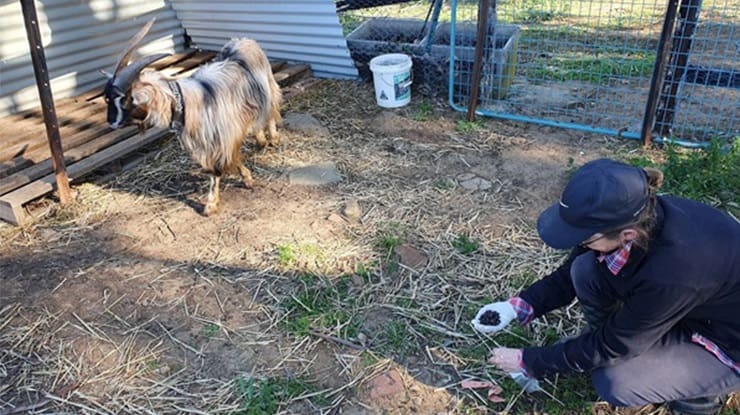
Goat dung sampling on one of the farms during the five-week validation study.
GOAT producers can undertake rapid on-farm worm egg count testing without having to send dung samples away to laboratories, a study of a new diagnostic technology has found.
A validation study funded by Meat & Livestock Australia of an on-farm worm egg count testing technology called FECPAKG2 has demonstrated its effectiveness.
The technology includes a microscopic camera and a web-based platform to connect producers to trained technicians for analysis and reporting.
The study compared results of worm egg count testing in goats using FECPAKG2 with those using an in-laboratory method known as Mini-FLOTAC, on individual and pooled worm egg counts over five weeks across nine mobs on six farms in New South Wales.
The results showed goat producers can use pooled counts to save time and money on worm egg count testing.
Goat producers can undertake rapid and accurate on-farm worm egg count testing without having to send dung samples away to laboratories, a study of new diagnostic technology has found.
The FECPAKG2 testing method is available in Australia for use by goat producers themselves, or alternatively in veterinary clinics or rural stores that service goat farms.
Dr Matt Playford, from Dawbuts Animal Health, led the study and said the ability to conduct on-farm worm egg counts to achieve rapid results offered many benefits to animals, producers and the industry.
“A common theme across the Australian goat industry is the difficulty of worm control, partly due to the goat’s differing behaviour and metabolism from other grazing herbivores and the lack of registered anthelmintic products, or drugs for parasite control, for this species.
“This results in poor goat welfare and productivity as well as potential violation of residue limits of anthelmintics in goat meat samples,” Dr Playford said.
“Rapid testing enables goat producers to make informed decisions about parasite management without delay and treat goats before they are at risk of death or reduced production.”
Results of validation study
The results of repeated worm egg counting on dung samples from goats over the five-week study showed that, despite unfamiliarity with FECPAKG2 in the early part of the trial by participating producers and other operators, a very high correlation between the methods was observed after three weeks.
Worm egg excretion by all mobs of goats was high during the five-week trial. Mean worm egg counts across all mobs ranged from 623 eggs per gram (epg) in week four, to 1408 epg in week one. Individual counts ranged from zero epg to 9940 epg.
A range of worm genera was observed, with Haemonchus, Teladorsagia, Trichostrongylus and Chabertia observed in larval cultures and Nematodirus eggs observed in worm egg counts.
Worm egg counts using the two methods were assessed on a week-by-week basis and correlation of worm egg counts between the two methods was moderate to high across the five-week trial.
Results of the pooled samples across the nine mobs were very similar to the mean of the individual counts, for both methods, with a trend towards higher correlation for the FECPAKG2 method.
Implications for goat producers
Dr Playford said the results mean that goat producers can use pooled counts to save time and money on worm egg count testing, unless individual counts are required for anthelmintic resistance testing or for management reasons.
“Sensitivity of the FECPAKG2 unit is 35 eggs per gram, which is appropriate for Australian goat herds, which typically have worm egg counts over 300 eggs per gram,” Dr Playford said.
“The level of zero counts for FECPAKG2 was higher than Mini-FLOTAC, due to Mini-FLOTAC’s sensitivity of 10 epg in this trial.
“The counts using Mini-FLOTAC were slightly higher than those using FECPAKG2 in each of the five weeks, due to the higher sensitivity. However, the difference was not significant in week four.”
Dr Playford said adoption of FECPAKG2 for routine monitoring of goat worm burdens and for testing the efficacy of drenches would lead to improved worm control in goats.
“This will, in turn, improve productivity and reduce the risk of violations of residues in goat meat or unacceptable animal welfare outcomes that threaten the sustainability of the Australian goat industry.
“One key advantage is that testing can be done at the point of care on-farm or at a nearby service provider without the need for sending dung samples through the mail to an accredited laboratory, or risking inaccurate results being done by an unaccredited provider,” he said.
“Another is that feedback on preparation and image capture can be given immediately to the operator and images of each test are kept on record for auditing.
“These features result in higher quality assurance, lower cost, greater convenience and lower biosecurity risk for both animals and humans compared to conventional methods.”
Source: MLA.

Hi
I’m in Ohio of the USA and would greatly appreciate more information concerning FECPAK
Thank you
Here in the UK we use Mini-Flotak on farm, not via a lab. Very quick and easy and much cheaper than FECPAK. Also more accurate at lower worm burdens than FEKPAK, as it says here. The Mini-Flotak is available to buy in Australia. So look at both systems before committing, would be my advice.
Leslie
Can you email me on [email protected]? I’m in the USA and would like more information about wormings. Thanks in advance
Janet Bush